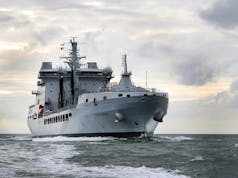The Ministry of Defence has released the Request for Information for advanced underwater force protection solutions.
Outlined in the RFI, the Ministry explicitly states, “The Royal Navy is seeking information on current and future Underwater Force Protection capabilities including portable or fixed sonar systems, other find capabilities, anti-diver and counter UUV capabilities.”
Delving deeper into the requirements, the RFI specifies, “UW PROTECT, within Navy DEV, are interested in exploring the options of deployable underwater protection systems which can be deployed on board all RN Vessels in both UK waters and overseas.”
The document further defines the operational expectations of these systems: “These systems should be able to detect and track all underwater contacts ranging from larger targets such as UUVs to smaller targets such as smaller UUVs, ROVs and Divers.” Additionally, it highlights the necessity for these systems to perform in diverse conditions, stating, “They should be able to operate with accuracy within busy harbour and anchorage environments which have a high traffic density.”
The RFI also addresses the practical aspects of system deployment and usability. It points out, “Such systems should be person portable, with a simple user interface, and be quick and easy to deploy at short notice.”
For long-term installations, the RFI expresses interest in “current and future fixed underwater protection capabilities which could be installed to protect UK national maritime infrastructure or installed within UK military ports to protect RN assets and facilities.”
This RFI aims to achieve four outcomes:
- Align the MOD requirement with industry capability and processes for procurement of the required solution.
- Develop a procurement strategy that will deliver best value for money for Defence.
- Implement an enduring solution that allows the Authority to plan its activity against an assured continuity of service, whilst also supporting ad-hoc, unprogrammed surges in demand.
- To inform a Procurement Strategy that enables the implementation of an enduring solution.
This RFI represents a strategic effort by the Ministry of Defence to gather essential information that will shape their approach to acquiring advanced underwater defence capabilities. With responses due by 5 January 2024, the outcomes of this RFI are poised to significantly influence the Royal Navy’s defence procurement and operational strategies in the coming years.














Trawlers use Fish finding detectors very successfully, not sure if this tech would be helpful.
Far better that we spend some of our precious taxpayer funds on something useful like this, given the large amount of underwater energy-related and communications infrastructure we rely on.
I assume the costs of these new systems will come out of the energy investment budget and not the MoD budgets. Or is this another hidden cost of net zero.
Does this cover SSN/SSBN-deployed UUVs?
If the European navy’s goi their heads together l, a coherent policy on protecting the underwater lines and pipes could be drawn up a system of UUV vessels like the British Cetus sys could be built with the view of constant patrolling along the lines might be the future of the underwater strategies
When I was working with NATO they had an ongoing project for this sort of thing and if i remember correctly Qinetq was part of it.
Our colonial cousins have a number of suppliers that they use for similar systems. Small transmitters and simple displays to protect harbours etc.
Bit of a step up from using 1lb scare charges if enemy divers are detected in ports or anchorages
I believe the Orcs used enslaved dolphins for this purpose then call it a Biotechnology weapon system 😀
Much like their “hypersonic” missiles.
The USN have Dolphins and Sea Lions for MCM and anti diver as well
Funny enough, I was thinking about diver detection the other week, and came across Atlas Electronik UK driver detection sonar system called ‘Cerberus Mod 2 Diver Sonar’. If that is what they are aiming for?
I’m glad we are thunking about this. Its back to the future to some extent as proven by the Ukrainians clever success against the Russians. Where are our X boat and CMB equivalents when you need them.
I think it was a few weeks ago, when a RAN ship had divers in the water clearing it props from tangled fishing gear. When a Chinese ship came near and started blasting away on active sonar. Even though the RAN said they had divers in the water! Deliberately blasting divers with a ship’s submarine hunting active sonar, is not great for diplomatic relations.
I did hear that sorry about the Chinese ship. From the video on YouTube, this product is purpose-built to detect divers in the water.
Not that it bothers the Chinese in any way
They will keep doing it and nobody will do anything about it.
Sadly true